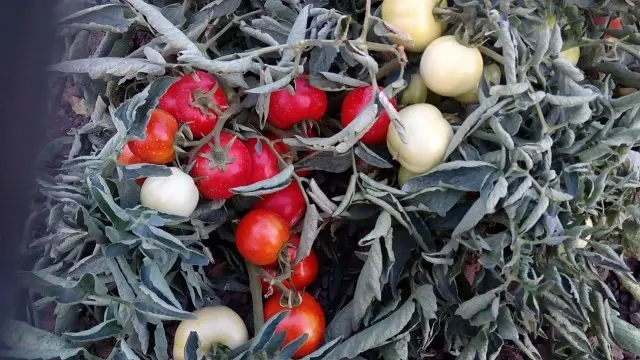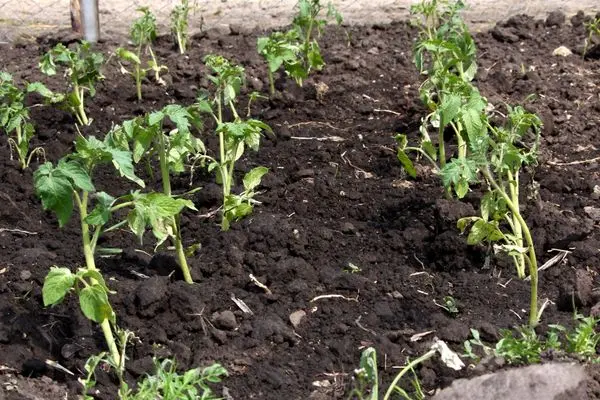Contents
Tomato Impala F1 is a hybrid of medium early ripening, which is convenient for most summer residents. The variety is resistant to many diseases, relatively unpretentious and bears fruit well even under adverse weather conditions. According to the place of cultivation, the hybrid is universal – it is adapted for planting both in open ground and in a greenhouse.
Description of Impala tomato
Tomatoes of the Impala F1 variety are classified as determinant type, which means that the bushes grow small – the hybrid is limited in growth, so the upper shoots do not need to be pinched. In open ground, tomatoes reach an average of 70 cm in height, however, when grown in a greenhouse, this figure increases to almost 1 m.
Bushes grow compact, but dense – the shoots are densely hung with fruits. They form brushes of 4-5 pieces. The inflorescences of the variety are simple. Internodes are short.
Brief description and taste of fruits
Tomatoes Impala F1 have a rounded shape, slightly flattened on the sides. The peel of the fruit is elastic, resistant to cracking during transportation over long distances and harvesting for the winter. Thanks to this, it is profitable to grow tomatoes for sale.
The mass of fruits is on average 160-200 g. The color of the peel is rich red.
The pulp of Impala F1 tomatoes is moderately dense, juicy. The taste is rich, sweet, but without excessive sugar content. In reviews, gardeners often emphasize the aroma of tomatoes – bright and peculiar.
The scope of fruits is universal. They are good for preservation due to their medium size, but they are also used for cutting into salads and for making juices and pastes.
Varietal characteristics
Tomatoes of the Impala F1 variety are a hybrid of medium early ripening. The crop is usually harvested in the last days of June, however, the fruits ripen unevenly. The exact dates are calculated from the moment the seeds are planted for seedlings – the first tomatoes ripen on about the 95th day (65th from the moment the seedlings were transplanted into open ground).
The variety demonstrates good fruit set regardless of weather conditions. The yield of tomatoes is consistently high – from 3 to 4 kg per plant.
The hybrid is resistant to many fungal and infectious diseases. In particular, the Impala F1 is rarely affected by the following diseases:
- brown spotting;
- gray spotting;
- fusariosis;
- cladosporiosis;
- verticillosis.
Pests infect tomato beds infrequently, so there is no particular need for any special preventive measures. On the other hand, spraying plantings against the fungus will not be superfluous.

Seed germination of the Impala F1 variety is maintained for 5 years.
Pros and cons of the variety
Tomatoes of the Impala F1 variety have many advantages, which distinguishes the hybrid from other types. It is especially attractive for beginners in gardening. The reason for this is the following qualities of tomatoes:
- relative unpretentiousness in care;
- high resistance to drought;
- resistance to most diseases typical of tomatoes;
- consistently high yields regardless of weather conditions;
- good transportability – the skin of the fruit does not crack during long-distance transportation;
- resistance to sunburn, which is achieved due to the density of foliage;
- long shelf life of the crop – up to 2 months;
- rich aroma of fruits;
- moderately sweet taste of pulp;
- versatility of the use of fruits.
The only pronounced drawback of tomatoes is their origin – Impala F1 is a hybrid, which leaves an imprint on possible methods of reproduction. It is possible to collect seeds of the variety manually, however, when sowing such material, the yield will decrease significantly, and many qualities of tomatoes will be lost.
Rules of landing and care
In order to achieve maximum yield from the bushes, it is necessary to create the best conditions for growing tomatoes. Of course, the variety is unpretentious, and will bear fruit well even with minimal care, however, these will not be the best indicators.
When planting Impala F1 tomatoes, the following recommendations must be followed:
- Best of all, tomatoes develop at a temperature of + 20-24 ° C during the day and + 15-18 ° C at night. At temperatures below +10°C and above +30°C, tomato growth is inhibited and flowering stops.
- The variety makes quite high demands on the level of illumination. The beds must be located in open sunny areas. The hybrid safely tolerates short rains and cloudy days, however, if such conditions persist for weeks, even genetically inherent endurance will not save planting. Prolonged cooling and dampness delay the ripening of fruits by 1-2 weeks, and their taste loses its original sweetness.
- Tomatoes bear fruit well on almost all soils, but it is better to give preference to light loamy and sandy loamy soils of medium acidity.
- Purchased from a gardening store or self-prepared, seeds are stored in paper bags in a dry place at a stable room temperature. The kitchen is not suitable for this due to temperature changes.
- It is better to plant purchased seeds, since under conditions of free pollination the hybrid loses its varietal qualities.
- For better survival of tomatoes, their root system must be treated with growth-stimulating preparations before planting.

The hybrid is planted in open ground in late March – early April, in the greenhouse – during the second decade of March.
Growing seedlings
The hybrid is propagated by seedling method. The procedure for growing tomato seedlings is as follows:
- Special containers for seedlings are filled with soil mixture from soddy soil, humus and mineral fertilizers. For 8-10 liters, there are about 15 g of potassium sulfide, 10 g of ammonium nitrate and 45 g of superphosphate.
- Shallow grooves are made on the surface of the substrate at a distance of 5 cm from each other. Seeds are laid out in them, keeping a distance of 1-2 cm. It is not necessary to deepen the planting material too much – the optimal planting depth is 1,5 cm.
- After planting the seeds, they are carefully sprinkled with moist soil.
- The landing procedure is completed by covering the container with plastic wrap or glass.
- For the best development of seedlings, it is necessary to maintain the temperature in the room at the level of + 25-26 ° C.
- The seeds will germinate in 1-2 weeks. Then they are transferred to the windowsill and the shelter is removed. The temperature is recommended to be lowered to +15°C during the day and +12°C at night. If this is not done, the tomatoes may stretch.
- During the growth of tomatoes, they are moderately watered. Excess moisture adversely affects the root system of tomatoes and can provoke a black leg disease.
- 5-7 days before transplanting into open ground, tomatoes stop watering.
- Tomatoes dive after the formation of 2 true leaves, which usually occurs 2 weeks after the appearance of the first shoots.
Seedling transplant
Impala F1 tomato bushes are quite compact, but plantings should not be thickened. Up to 1-5 tomatoes can be placed per 6 m², no more. If this limit is exceeded, the fruits of tomatoes are likely to be crushed due to the rapid depletion of the soil.
Impala F1 tomatoes are planted in holes pre-filled with a small amount of fertilizer. For these purposes, a mixture of superphosphate (10 g) and the same amount of humus are suitable. Water the tomatoes immediately after planting.

Care of tomatoes
Bushes of tomatoes form in 1-2 stalks. The garter of Impala F1 tomatoes is optional, however, if a large number of large fruits have formed on the shoots, the tomato bushes may break under their weight.
The Impala F1 variety is drought tolerant, however, regular watering is necessary for good fruiting. Planting should not be flooded to avoid root rot. Humidity fluctuations lead to cracking of the skin of the fruit.
When organizing irrigation, it is recommended to focus on the state of the topsoil – it should not dry out and crack. Impala F1 tomatoes are watered under the root so as not to provoke leaf burns. Sprinkling negatively affects the formation of flowers and subsequent fruiting. It is desirable to complete each watering with shallow loosening of the soil and weeding.
Tomatoes bear fruit well even without fertilizers being applied to the soil, but at the same time they respond well to soil enrichment with minerals and organic top dressing. Tomatoes are especially in need of potash fertilizers during fruit set. You can also fertilize plantings with phosphorus and nitrogen. According to the rules of agricultural technology, it is recommended to add magnesium to the soil during the ripening of tomatoes.
Mineral dressings are better absorbed by Impala F1 tomatoes if they are applied to the soil in liquid form, preferably after watering. The first top dressing is carried out 15-20 days after planting tomatoes in open ground or a greenhouse. This occurs at the time of the formation of the ovaries of the first inflorescences. Tomatoes are fed with potassium (15 g) and superphosphate (20 g). The dosage is calculated for 1 m2.
The second top dressing is carried out during the period of intensive fruiting. To do this, use ammonium nitrate (12-15 g) and potassium (20 g). The third time the plantings are fed at will.
Stepchildren on tomatoes are recommended to pinch from time to time. For the accelerated development of tomatoes, it will also be useful to mulch the plantings.
Conclusion
The Impala F1 tomato has gained popularity among gardeners due to its rich taste and high yield even in adverse weather conditions. The variety is not without flaws, however, ease of care and resistance to a number of diseases fully pays for them. Finally, the hybrid is adapted for cultivation in most regions of the country. These qualities make the Impala F1 tomato an ideal option for novice summer residents who are just trying their hand and do not know all the intricacies of gardening.
You can learn more about growing tomatoes from the video below:









